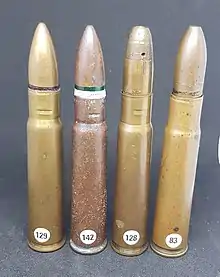Ho-103 machine gun
The Type 1 machine gun (signifying its year of adoption, 1941) was a Japanese aircraft-mounted heavy machine gun widely used during World War II. It was also known as the Ho-103.[3] The weapon itself was largely based on the American .50-caliber (12.7 mm) M2 Browning heavy machine gun, while the design of its ammunition was initially sourced from various Italian Breda-SAFAT 12.7 mm rounds. Japanese-designed and produced rounds would eventually mostly replace these imported rounds.[1]
| Ho-103 machine gun | |
|---|---|
 12.7 mm Ho-103 machine gun on display at the Steven F. Udvar-Hazy Center | |
| Type | Machine gun |
| Place of origin | Empire of Japan |
| Service history | |
| Used by | Imperial Japanese Army |
| Wars | World War II |
| Production history | |
| Produced | 1941-1945 |
| Specifications | |
| Mass | 23 kilograms (50.7 lb) |
| Length | 1,267 mm (49.9 in) |
| Barrel length | 800 mm (31 in) |
| Cartridge | 12.7×81mmSR Breda[1] |
| Action | Recoil operation |
| Rate of fire | 983 RPM[2] 400 RPM (synchronized) |
| Muzzle velocity | 780 m/s (2,600 ft/s) |
| Feed system | Belt 250 rounds |
| Sights | Iron |
The Ho-103 achieved a slightly higher rate of fire (RoF) than the contemporary aircraft-mounted M2 Browning machine gun (AN/M2) by using the smaller, lower velocity semi-rimmed Breda-SAFAT 12.7 mm cartridge. The round was intermediate in length (88 mm) between the WWII German 13 mm calibre MG 131's ‘short’ 64 mm cartridge, and the ‘long’ 99 mm cartridge of the M2 Browning. A high RoF was very desirable among aircraft weaponry; with the ever-increasing speeds of fighters, the window to score hits grew smaller and smaller. Thus, a higher RoF provided a greater density of fire and therefore a greater chance to hit. The compromise of a shorter cartridge to achieve this had drawbacks: Ho-103 rounds had a shorter maximum and effective range, as well as a lower velocity than their M2 Browning counterparts. To compensate for the mild to moderate loss in performance, the gun was frequently loaded with high-explosive incendiary (HEI) rounds. The Italian Breda-SAFAT HEI ammunition was initially copied as the fuzed Ma 103 round, until the fuzeless Ma 102 round was developed, carrying over double the high explosive content of the Ma 103.
Ammunition
The Ho-103 used a wide variety of ammunition; Most was produced in Japan, but some was imported from Italy (such ammunition was identical to that used in Breda-SAFAT HMGs). Types of ammunition used by the Ho-103 include:[4][5][6]

- Ball (full metal jacket), marked with a pink or red seal around the casemouth.
- Armor piercing (AP) of Italian origin, marked with a black tip.
- Armour piercing tracer (AP-T) with red tracer, marked with a pink tip and green and white seal around the casemouth.
- AP-T with brighter-burning, longer-lasting red tracer, uncolored tip and black seal around the casemouth.
- AP-T with white tracer, uncolored tip and green and white seal around the casemouth.
- Fuzed high-explosive incendiary (HEI) of Italian origin, its body painted blue or red. Contained 0.8 grams (12 gr) of PETN and incendiary composition.
- Ma 103 fuzed HEI, marked with a white seal around the casemouth. Contained 0.8 grams (12 gr) of RDX and 1.46 grams (22.5 gr) incendiary composition.
- Ma 102 fuzeless HEI, marked with a dark purple seal around the casemouth. Contained 2 grams (31 gr) of PETN + RDX and 1.46 grams (22.5 gr) incendiary composition.
Variants
The Type 1 was produced in two variants. The Ho-103 was used in fixed installations, while the Ho-104 was used in flexible installations.[1]
Design
The 12.7×81mm cartridge allowed the Type 1 to fire at a rate of 900 RPM, but the poor suitability of the Browning's action to synchronization reduced the rate of fire to 400 RPM in synchronized installations.[1] However, the Japanese source and Allied Intelligence reports[7] did not mention that this machine gun had a propeller synchronization flaw.
References
- Rottman, Page 22.
- Catalog of enemy ordnance material. Report No. 12-b(2), USSBS Index Section 6
- "JAPANESE ARMY". www.dragonsoffire.com.
- USGPO (16 Mar 1953). "4". Japanese Explosive Ordinance (Army Ammunition Navy Ammunition). p. 279. TM 9-1985-5/TO 39B-1A-12. Archived from the original on 2021-09-20. Retrieved 2021-09-20.
Ball... A. P . T... H. E. I . fuzed... H. E. I . fuzeless... H. E . I . fuzed (Italian)... Tracer... A.P. (Italian)
{{cite book}}:|work=ignored (help) - Chief Inspector of Ammunition (1945). Japanese Ammunition. pp. 3–4. Archived from the original on 2021-09-09. Retrieved 2021-09-09.
{{cite book}}:|work=ignored (help) - Japanese Ammunition 1880-1945 vol. 1, Ken Elks, ISBN 0955186226
- "Catalog of enemy ordnance material. Report No. 12-b(2), USSBS Index Section 6 - NDL Digital Collections". dl.ndl.go.jp. Retrieved 2020-06-25.
Bibliography
- Rottman, Gordon L. (2010). Browning .50-caliber Machine Guns. Oxford, UK: Osprey Publishing. ISBN 978-1849083300.